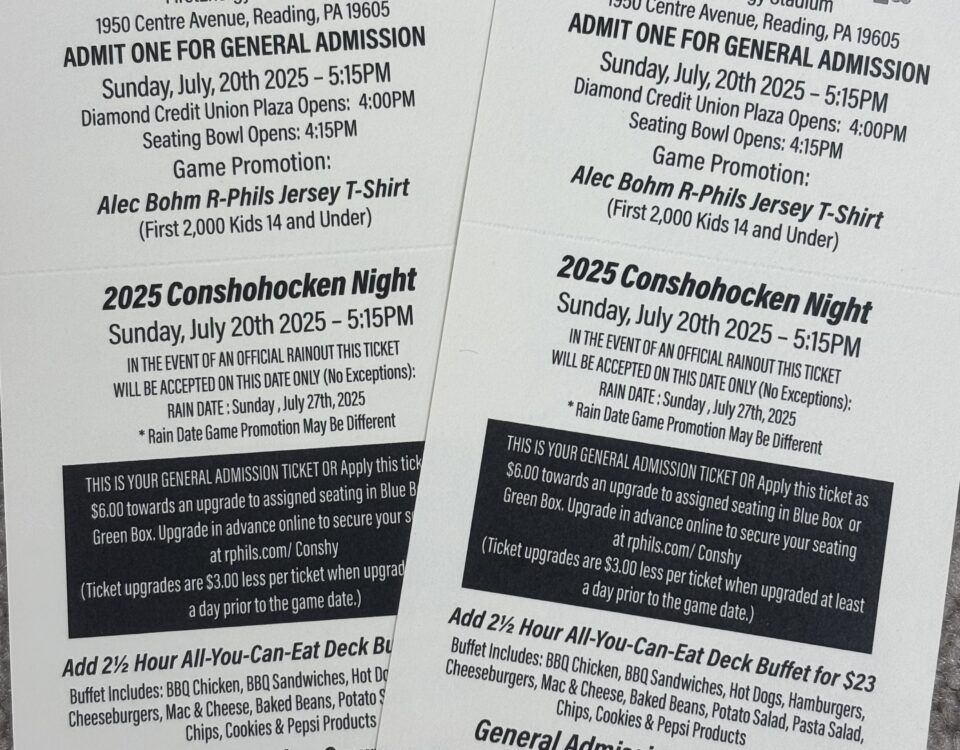Saint Matthews New Parish Hall – photos
September 27, 2016Road Trip 2016 part two Christmas and a Baseball Game
October 5, 2016Road Trip 2016 Kent State University
Road Trip 2016
Kent State University
All These Years Later
By Jack Coll
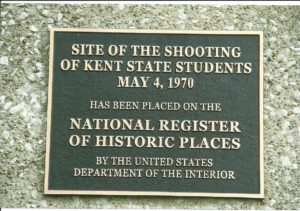
Donna and I have traveled across the country a couple of times over the years and this past August we took a two week trip to visit the Black Hills of South Dakota.
Seeing Mt. Rushmore, the Badlands, the Black Hills and the Crazy Horse Monument have been on my checklist for a number of years along with a couple of other stops along the way.
One of those stops on the way to Rushmore was a visit to Kent State University to pay tribute and say a prayer for the victims of the Kent State Massacre that happened on May 4, 1970.
Years after the four students were killed and nine other students injured by Ohio National Guardsmen the school embraced the disgraceful incident and have recognized it as a part of American history, at Kent State University it’s simply called “May 4th.”
So eight hours into day one of our two week long trip we pulled into the Kent State University campus and had no trouble finding the monument honoring the deceased students. The University has a May 4th museum, a well-marked walking tour complete with plaques and photographs along the way, and bollards marking the site of the executed students.
For those familiar with the layout of the school grounds at the site of the protest and/or have seen the documentaries on the May 4th massacre, when you walk behind the Taylor Building the sight of the commons with the freedom bell takes your breath away. This is where the student protest was centered.
College campuses throughout the country were on edge and many of them protesting with sit-ins and other activities when President Nixon went on National television on April 30, 1970 announcing that he was increasing military forces by as many as 150,000 troops for the invasion of Cambodia.
At a time when getting out of Vietnam was the goal, Nixon wanted to fast track the draft to include another 150,000 young men and women. Young Americans who felt the war had run its course and believed America was on the way out of Vietnam were extremely disappointed with Nixon’s decision to send in more troops.
A Friday night rally at Kent State University on May 1, was organized by students, the rally was peaceful, and well attended. Students met in the commons to light candles and chanted for an end to war. During or shortly after the rally the vacant ROTC building located on school grounds was burnt to the ground prompting the Governor of Ohio to dispatch nearly 1,000 National Guardsman to the campus.
By Monday May 4, there was some rock throwing by the students and a number of chants at the Guardsmen “One Two Three Four-we don’t want your f______ war,” and “Pigs Go Home.” The protest was now in its fourth day having started on April 30. The National Guardsmen were clearly becoming un-easy. The Guardsmen dispersed the crowd of students in the commons and around the freedom bell, the students went in two directions.
A group of students rushed around the Taylor building and assembled in the parking lot below the gazebo and steel sculpture behind the Taylor building. The guardsmen assembled on top of a small hill under and around the gazebo. The Guardsmen became un-easy, 67 shots were fired in 13 seconds into the crowd of students. When the smoke cleared from the gun-shots four students laid dead, nine more students were injured and dozens more were injured in the panic to escape the gunfire.
Lying dead in the parking lot was Jeffery Miller, just three months earlier Miller transferred to Kent State from Michigan State University. Miller quickly became friends with Allison Krause and Sandra Lee Suheuer who were both also killed by Guardsmen on May 4.
Most people are familiar with the iconic Pulitzer Prize winning photograph taken by student photographer John Filo, who captured Mary Ann Vecchio kneeling over the body of Miller screaming. In an interview some years later Vecchio stated that she was screaming for help and that she felt so helpless.
Vecchio was a 14 year old runaway from Florida. She was hitchhiking her way across the country and found her way to Kent State University on May 1, 1970. She was invited to crash at a student’s house and was told of a rally on Monday, May 4, so she went.
Sandy Suheuer just happened to be walking to class on her way to take a midterm exam when she was fatally shot in the neck with an M-1 rifle from a distance of 130 yards. Sandy was an honor student in speech therapy and was walking with one of her speech and therapy students across the green. Neither Sandy nor the young man had anything to do with the assembly of students on the green.
The young man walking with Sandy to their next class was named Tom Grace and was shot in the ankle. Neil Young referred to both of them when he wrote the lyric in the song “Ohio,” The reference in the song was made through the eyes of Grace when Young wrote and sang,
“What if you knew her, and found her dead on the ground.”
Allison Krause was an honor student at Kent State participating in the protest against the war and the presence of the National Guard on the Kent State campus. On May 4, while participating she was shot in the left side of her body fatally wounding her. The rifles and bullets being used by National Guardsmen were kill weapons. The bullet entered and exited Allison’s upper left arm, and then entered her left lateral chest, fragmenting on impact and causing massive internal injuries. She died later that day.
William Schroeder was the fourth student killed in the massacre. Schroeder was not taking part in the protest but like Sandy Suheuer was simply walking to his next class. Schroeder was an Eagle Boy Scout from Cincinnati Ohio. Schroeder applied for the Army Reserve Officer Training Corps (ROTC) Scholarship. He received the Academic Achievement award from both Colorado School of Mines and from Kent State University, where he was a psychology student.
The shootings led to protest and a national student strike, causing hundreds of campuses to close across the country because of both violent and non-violent demonstrations. The Kent State campus remained closed for six weeks.
Two days after the Kent State massacre President Nixon went on National television and talked for two minutes about Kent State. When asked about the Kent State University incident as stated by a reporter, “In light of the Kent State University incident, in your judgment when cops and troops are ordered to clear a campus area and rocks are being thrown was this handled the proper way?
Nixon’s reply was, “We think we’ve done a rather good job here in Washington in that respect.”
“If there’s one thing I’m personally committed to it’s this, I saw the picture of them four youngsters in the Evening Star the day after that tragedy and I vowed then that we were going to find methods that would be more effective to deal with these problems of violence, methods that would deal with those who would use force and violence and endanger others and at the same time would not take the lives of innocent people.”
Three days after Nixon’s speech more than 100,000 people demonstrated in Washington, D.C. against the war.
Nearly two years earlier a scuffle broke out in Orange, South Carolina in February 1968. Some 200 students had gathered on the campus of South Carolina State University to protest the continued racial segregation of the All Star Bowling Lanes after passage in 1964 of Federal Legislation prohibiting such action. That night students started a bonfire. As police attempted to put out the fire an officer was struck and injured by an object. Police later said they believed they were under attack by small weapons fire. The officers fired into the crowd, killing 18 year old Samuel Hammond Jr., 17 year old Delano Middleton, and 19 year old Henry Smith and wounding 27 other students.
Nixon apparently learned nothing from the 1968 South Carolina shooting, and apparently learned nothing from the 1970 Kent State shooting because just eight days after giving his fabulous speech about not taking the lives of innocent people a massive shootout at Jackson State University in Jackson Mississippi took the lives of two students on May 14, 1970. Jackson State University was an all-black school at the time and students there were protesting against the Vietnam War, specifically the United States invasion of Cambodia. Along with the two dead students twelve others were wounded in what was declared a small miracle due to the fact that the gunfire lasted for 30 seconds and at least 140 shots were fired from 30-50 feet away from the women’s dormitory. Every window in the Alexander Hall dormitory was shot out.
In 2010, the site of the Kent State shootings was placed on the National Register of Historic Places by the Department of Interior with support of the Ohio Preservation Office.
A side note to the Kent State Shootings is that Chrissie Hynde attended Kent State University as an art student for three years and although she wasn’t on the protest grounds on May 4, the boyfriend of one of her best friends was one of the four victims that day. Chrissie Hynde is a founding member and lead singer of a rock group known as “The Pretenders.”
Should you be traveling into Ohio, The Kent State campus is beautiful, the outlines of the bodies from May 4, 1970 will take your breath away. The school and its students have moved on, the campus is a vibrant place for the young students, but if you are of a certain age, the cloud that hangs over the site of the campus massacre will bring you to your knees when you walk the grounds.
NOTE:
It was this incident that prompted Neil Young to pen the song “Ohio” within a week of the shootings. The song “Ohio” really only has ten lines in the song but it’s that cutting guitar riff that actually sends chills up your spine.
“Ohio”
Written by Neil Young
Recorded by Crosby Stills Nash and Young
Tin Soldiers and Nixon coming.
We’re finally on our own.
This summer I hear the drumming,
Four dead in Ohio.
Gotta get down to it
Soldiers are cutting us down
Should have been done long ago.
What if you knew her
And found her dead on the ground
How can you run when you know?
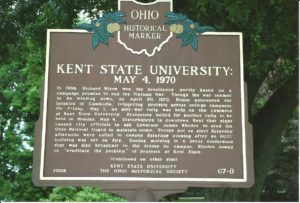
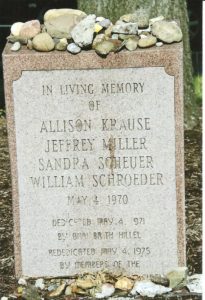

‘Bollards outline where 4 students laid dead in the parking lot at Kent State. In the corner of each outline is the students name that was killed in that spot. Jeffrey Miller was killed here, where the photo of Mary Ann Vecchio was kneeling next to his body was taken.”
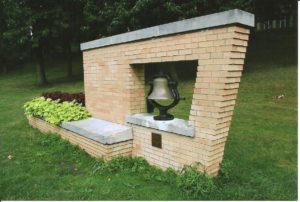
The Freedom Bell located on the Kent State Campus Commons. The Commons were ground zero for the student protest.
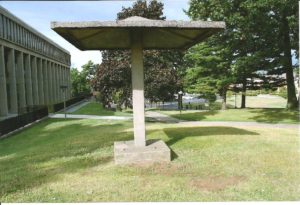
National Guardsman lined up at the top of the hill. Most of them took a knee, raised their M-1 rifles and opened fire on the students. 67 shots were fired in 13 seconds, killing 4 students.
Part Two of our vacation…. Coming soon.

